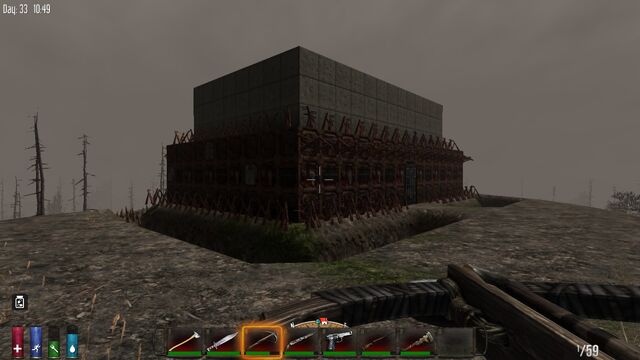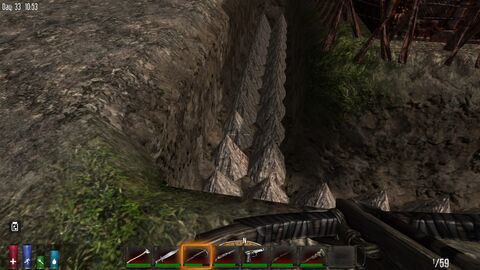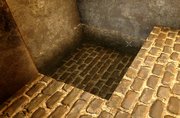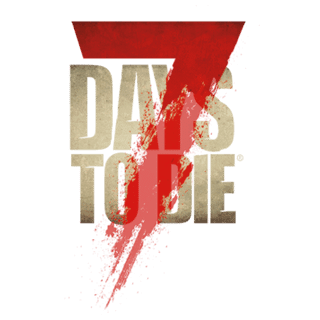Settler Play-style is a term for players that rely upon building a well-fortified base that can be effectively defended and utilizing game features like farming, mining and forging to acquire a steady source of food and resources to become relatively self-sufficient, and is the complete opposite of the Nomadic Play-style, which encourages constant movement, scavenging and hunting. The Settler Play-style relies more on choosing a good location for constructing a large fortress based on the abundance of surrounding resources and its ability to be easily defended, and requires construction of defenses and manipulating available resources to their greatest utility. The Settler Play-style can be more easily stretched into the late-game than the Nomadic Play-style, though it requires more proficient use of time-management than the latter.
As with the Nomadic Play-style, this guide is written for the default map, Navezgane. Just as with the Nomadic Play-style, the Settler Play-style can be achieved on a randomly-generated map, but is slightly more difficult because the player will lack a pre-existing knowledge of the map. The Settler Play-style is however easier to utilize on a generated map because it does not require the player to move extensively about the map after finding a good location for the player's primary base.
Definition[ | ]

Settler Play-style Fortress
The Settler Play-style is defined by the construction of a single, central home-base from which the player will perform all day-to-day survival tasks like farming and crafting, as well as defend against hordes. During the day, the player will mine, farm and craft to produce the necessary resources to maintain their base, occasionally making excursions out into the map surrounding them to find additional supplies and necessary things like skill books. During the night, the player will confine themselves to the interior of their base or no farther than the immediate exterior, relying on strength of arms and their constructed defenses to protect them. The Settler Play-style player tends to throw away less resources than the Nomadic Play-style player, opting instead to stock-pile all resources they acquire in storage containers inside their base in anticipation of a shortage.
Building[ | ]
Construction is perhaps the most important aspect of the Settler Play-style besides simply surviving. The Settler constructs a single large base and continuously fortifies it and builds defenses surrounding it to stop any incoming hordes or hostile players, staying at this central fortress until it becomes absolutely necessary to vacate.
The Settler spends most of their time trying to acquire the necessary components to obtain the strongest building materials possible such as Reinforced Concrete and effective defenses against attack such as Wood Spikes and Barbed Fence Wire.
Building Tactics[ | ]
There are many strategies a Settling player can use when constructing their central fortress.
Finding a Good Location[ | ]
One of the most important aspects of choosing a location to build a central base is the defensibility of the spot. Another important factor is its proximity to resources. The following factors generally affect this aspect of a location:
- Flat ground is generally good for constructing consistent, uniform defenses around a base and building a symmetrical foundation, making repairs more systematic and quick to perform. This also provides a level playing field to spot incoming enemies and hostile players.
- Hilly ground can be utilized by a Settling player to create a "King-of-the-Hill" type base with a large field of view around the base, allowing enemies and hostile players to be spotted from a long distance away. However, hilly ground can be more difficult to build a secure, uniform structure upon.
- Building nearby to a large amount of pre-existing buildings can be very advantageous because it provides an abundance of initial resources to start the player's base off on the right foot. However, large clusters of generated structures tend to have a large amount of zombies spawning consistently in the area, making it somewhat dangerous for the early-game player.
Designing the Base[ | ]
There are many different ways a player can design their fortress. However, there are a few good practices and tips a player should follow when planning out their base.
- A common method of designing a fortress in the Settler Play-style is to use a pre-existing building as a sort of framework from which to build off. If this is the style chosen, the player should look for buildings at least two, if not three, stories high as this will provide them the safest living area and give them plenty of distance between themselves and the zombies on the ground. The player should be careful, however, as the best buildings to use for this purpose are usually found in the more enemy-populated areas of the map.
- The ideal Settler Play-style fortress should be just large enough to accommodate the amount of players that will regularly occupy it as well as have enough room for storage of an equally appropriate amount of essentials like food, weapons and ammunition. However, the fortress should also be small enough that all areas can be given equal attention and be properly monitored during a horde attack.
- Building the outer wall of the base to have multiple layers is a good way of giving the player some extra time during a horde attack to create a strategy and begin eliminating enemies in the most resource-efficient and safe manner possible. These extra layers will give the zombies more material to move through, making it take them a significantly greater amount of time to reach the interior of the base or cause serious damage to the Structural Integrity of the building.
Building Defenses[ | ]

Trench filled with Wood Log Spikes
If a Settler wants to withstand a horde of enemies, building appropriate defenses is absolutely essential. Well built defenses should stop zombies from coming in direct contact with the walls of a Settler's fortress in large numbers. The following are some tips on building effective defenses for one's base:
- Digging a trench around the outside of the outer wall of a fortress is a common defensive measure. Ideally, this trench should be at least two blocks wide and three blocks deep, to prevent zombies from easily jumping out of the trench. It should also contain some sort of damaging block at the bottom, such as Wood Spikes or Iron Spikes.
- NOTE: Iron Spikes, take less damage than Wood Spikes when they come in contact with zombies and players. This provides the advantage of having to worry less about crafting replacements or making repairs.
- Zombies will attempt to avoid Barbed Wire by circumventing it, so it is an effective way of directing the flow of enemies towards a specific area. This target area can be a trench or a minefield, or somewhere the player can quickly and efficiently eliminate the enemies.
- Multiple doors will prevent zombies from reaching the interior of a player's base before they can be eliminated. Just as with the materials the player uses to build the structure of their fortress, the player should try to build the strongest doors possible. The strongest craftable door in the current version of 7 Days to Die is the Vault Door , which can be upgraded twice, first to the Vault Door v2, and finally to the Vault Door v3, the strongest obtainable door in the game.
- Building your base in such a way as to require the player to climb a ladder to reach the interior is a good way of preventing zombies from ever reaching the inside of the fortress and surrounding the player short of collapsing the entire structure.
Equipment[ | ]
Settling players must try to obtain the best possible tools and weapons to construct the necessary components of their base and effectively defend it. The following lines explain the usefulness of each tool or weapon for a Settling player.
Tools[ | ]
- The Stone Axe is a good starting tool that can be constructed immediately and perform all necessary tasks, but must be quickly replaced by better equipment.
- The Fireaxe is an excellent tool for acquiring the wood needed to construct most types of defenses which are essential for defending a base, and can be acquired relatively quickly if the player can construct a Forge.
- The Pickaxe is essential for the Settling player because it is the primary tool for mining, and allows the player to easily and efficiently obtain metals to craft their own ammunition and tools.
- The Shovel is good for constructing defenses such as spike-filled trenches, and is far more effective than the Stone Axe.
- The Auger and Chainsaw are the ultimate objective for the Settling player, as they are the most efficient tools in the game. The gas needed to use them can be acquired by farming corn to produce Grain Alcohol.
Weapons[ | ]
Weapons are categorized into three types: melee, ranged and explosive.
Melee weapons, while being generally dangerous to use against large amounts of enemies, are good for use by a Settling player if the player can construct their base in such a manner as to funnel the flow of enemies into a tight channel or corridor, allowing them to quickly kill large amounts of zombies without the possibility of being surrounded. In both Survival SP and Survival MP, however, firearms still maintain a higher level of effectiveness and safety than melee weapons. Melee weapons do not require ammunition, but this is a more important factor to the Nomadic player than the Settling player as the Settler tends to have access to much greater amounts of renewable ammuntion.
Besides the Wooden Bow and Crossbow, ranged weapons are mainly firearms. Ranged weapons are safer to use than melee weapons, and provide a higher kill-rate. Even though most ranged weapons are firearms and thus require ammunition that are not nearly as easy to produce than the Crossbow Bolt, this is not a problem for the mid- to late-game Settling player because by this point they should be capable of producing their own ammunition by mining, forging and crafting the necessary components. However, Brass may be a limiting resource mid-game. In the early-game, ammunition should be used sparingly just as with the Nomadic player.
Explosives are all items, crafted or otherwise, that produce an explosion damaging all blocks and/or entities in a certain surrounding radius. Explosives are very effective at defending a base, but should be used with caution as they can damage the structural integrity of a Settling players base, as well as be lethal if the player is caught in the blast radius and is unable to escape in time.
Melee Weapons[ | ]
- The Iron Sledgehammer is the most damaging melee weapon in the game and thus is a great tool to have at all times. Its usefulness extends to its ability to do decent damage to stone materials.
- The Hunting Knife is also another damaging melee weapon (a single blow to the head drops most zombies). Though it does less damage than the Sledgehammer, it has a faster swing speed and requires less Iron Ingots. However, its recipe book must be found before it can be crafted.
- The Stone Axe is also a crudely effective melee weapon as it gives the most item-to-condition efficiency. A patient player can opt for the Stone Axe as their main melee weapon, but should be mindful that it require more hits depending on difficulty, and should always aim for the head.
Ranged Weapons[ | ]
- The Wooden Bow is the easiest to obtain ranged weapon requiring only Wood and Plant Fibers to craft and has equally cheap ammunition. However, it is also slow firing, difficult to use effectively and very weak compared to the firearms, making it unsuitable as a long term solution for the Settler.
- The Blunderbuss is almost as easy to acquire as the Wooden Bow, but has somewhat more difficult to produce ammunition. At close range it is very effective and as such is a workable weapon for the skilled Settler, but it should be replaced as soon as possible with a more powerful firearm such as the Shotgun.
- The Pistol is a useful skirmishing weapon that uses the rather common 9mm caliber. However, it is bested by most other weapons, given its low damage per shot.
- The Shotgun and its sawed-off variant is one of the best skirmishing ranged weapon given that an accurate shot is capable of instantly killing even the strongest of infected or the most armored of players. However, an inaccurate shot that does not land all of a shell's pellets will not inflict the largest possible amount of damage. The sawed-off variant has a wider spread and is more useful against hordes. Shotgun Shells can be crafted by the Settling player relatively easily. The only component that cannot be obtained through mining and forging is Paper, which is itself quite common, making the ammunition fairly easier to produce than most other types of ammunition due to the recipe not requiring Bullet Casings.
- The Hunting Rifle has fairly expensive to produce ammunition, but can easily one-shot any zombie or player with a headshot. It isn't fit for a rushing combat style, but rewards patient players. The same goes for the Sniper Rifle, which is much more rare to find and harder to craft, but possesses huge damage potential.
- The Crossbow makes dealing with hordes easier if the player is very accurate - they make practically no noise and will only alert zombies if they are hit but not killed. When fighting players, the element of surprise is crucial - the Crossbow isn't a great weapon in a straight fight.
- The SMG is a top-tier player-killing weapon, but requires extensive searching and ammo-making to be useful.
Resources[ | ]
The Settler Play-style is largely based around the concept of acquiring and stockpiling as many resources as possible, primarily food and clean water, weapons, ammunition and medical supplies. Some of the more basic of these resources can be obtained through scavenging. However, the ultimate goal of the Settler Play-style is self-sufficiency, making this type of resource gathering unsuitable for the Settler, who must instead find other, more renewable methods of production.
Food[ | ]
The most obvious choice for food production for the Settler Play-style is Farming. This is currently the only renewable method of food production in 7 Days to Die as the product can be reduced back into seeds through crafting. Thus, once the player has established a sufficient farm, food becomes a non-issue.
Water[ | ]
An unlimited water source can be created by using a Bucket and a 2x2 space. Once water is removed using a Empty Water Jar, you can scoop a square of water and replace it, refilling the 4 squares.

A 2x2 water supply.
